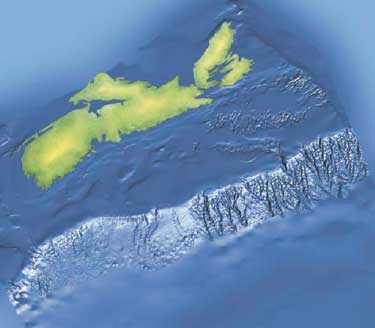NOVA SCOTIA CANADA: THE NEXT PLAY
Evaluating Scotian Shelf Deepwater
Although much work remains to be done, resource assessments so far give impressive numbers
Arthur G. Kidston, David E. Brown, Brian Altheim and Brenton M. Smith, Canada-Nova Scotia Offshore Petroleum Board, Table Rock Resources Ltd., Halifax, Nova Scotia, Canada
Recent interest in the deepwater offshore Nova Scotia has been driven by industry’s successes in other deepwater basins. Atlantic-facing look-alike basins have attributes reflected in the Nova Scotia region and were used as analogues for the Scotian Slope deepwater slope assessment.
In September 2001, the Canada Nova Scotia Offshore Petroleum Board (CNSOPB) began an evaluation of the hydrocarbon potential for the deepwater Scotian slope region. This was completed in 20021 and updated in late 2006.
The 2002 assessment was based on newly acquired (by TGS), regional seismic profiles along the entire Scotian slope and adjacent margin. Twelve play types were identified, and the results of the resource assessment are presented as probability distributions for oil, gas, solution gas and natural gas liquids for each play. These were statistically summed and total values defining both in-place and recoverable resources were generated. The analyses also presented all the values for geological risk at both the play and prospect level.
The assessment of the undiscovered gas potential for the deepwater slope offshore Nova Scotia reveals the potential for between 15 and 41 Tcf of gas, depending on the assumed geological risk factors. The oil potential of 2 to 5 Bbbl is very significant and in keeping with the high oil to gas discovery ratios seen in other global deepwater areas. The ranges for the unrisked and risked categories indicate the broad spectrum of possible outcomes. Additionally, the associated gas and natural gas liquids are also significant
 |
The Scotian Shelf and deepwater slope
|
|
The impact of these numbers, on a risked basis, was to basically double the gas potential with higher significant oil potential. When added to the 18 Tcf estimated from earlier GSC and the Canadian Gas Potential Committee (CGPC) estimates on the Scotian Shelf, the 15 Tcf for the slope region gives a total potential of 33 Tcf. Similarly, adding the traditional 1 Bbbl of oil (and liquids) to the 2 Bbbl for the slope offers a total potential of 3 Bbbl of oil.
The undiscovered potential for the deepwater slope, on a risked mean recoverable basis, is 15 Tcf of gas and 1.7 Bbbl of oil, with solution gas of 2.6 Tcf and NGLs of 500 MMbbl.
The undiscovered potential on an unrisked mean recoverable basis (i.e., assumed proven plays) is 41 Tcf of gas and 4.7 Bbbl of oil with solution gas of 7.5 Tcf and NGLs of 1.2 Bbbl. So, the forecast window, in very general terms, is 15 to 41 Tcf of gas and 1.7 to 4.7 Bbbl of oil.
After the release of the 2002 CNSOPB assessment, industry drilled six deepwater wells on the Scotian Slope in the 2002-2004 period, with one gas discovery (Annapolis), one gas show (Newburn) and four dry wells.
The most important insight from these wells, based on bio-stratigraphic data and paleo-environmental interpretations, was the realization that the Cretaceous sediments, presumed to have been deposited in a middle to lower slope setting, were in fact deposited in much shallow outer shelf to upper slope environments. This has a profound yet overall positive impact in determining the location of potential turbidite sand successions, facies types, plays and play types for future exploration opportunities along the entire Scotian Slope.
In late 2006, the CNSOPB completed its review of the 2002 assessment incorporating the results from the six new wells and additional seismic data with only modest revision to the earlier numbers:2
The challenge for future deepwater exploration is to better seismically image the Jurassic and Cretaceous stratigraphic succession, in particular, potential reservoir sand facies, and to determine optimal depositional fairways. Shallower Tertiary age sediments may also be prospective for oil discoveries.
Offshore Nova Scotia contains a number of Paleozoic and Mesozoic sedimentary basins and features including the Fundy Basin, Maritimes Basin, Scotian Basin, Jurassic Abenaki Carbonate Bank, Orpheus Graben and the Deepwater Slope region. Most of these have proven hydrocarbons, yet a modern, comprehensive assessment of the collective resource potential for all the areas does not exist. Therefore, the best estimate for offshore gas resources must exceed 40 Tcf. 
LITERATURE CITED
1 Kidston, A. G., Brown, D. E., Smith B. M. and B. Altheim, Hydrocarbon potential of the deep-water Scotian Slope,. Canada-Nova Scotia Offshore Petroleum Board, Halifax, 111p, 2002.
2 Kidston, A. G., Smith, B., Brown, D. E., Makrides, C. and B. Altheim, Nova Scotia deep water post-drill analysis 1982-2004, Canada-Nova Scotia Offshore Petroleum Board, Halifax, Nova Scotia, 180 p. plus enclosures, 2007.
|



